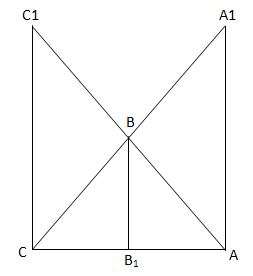Question
B1 is a point on the side AC of ∆ ABC and B1B is
joined. line is drawn through A parallel to B1B meeting BC at A1 and another line is drawn through C parallel to B1B meeting AB produced at C1. ThenSolution
 ∆AA1C & ∆BB1C AA1 ‖ BB1 (BB1) / (AA1) = (B1C) / (AC) By ratio of Similarity in ∆ACC1 ~ ∆ABB1 = BB1 ‖ CC1 = (BB1) / (CC1) = (AB1) / (AC) = (BB1) / (CC1) = (AC – B1C) / (AC) = (BB1) / (CC1) = 1 – ((B1C) / (AC) from (1) (BB1) / (CC1) = 1 – (BB1) / (AA1) BB1[1/CC1 + 1 / AA1] = 1 = (1 / CC1) + (1 / AA1) = (1 / BB1)
∆AA1C & ∆BB1C AA1 ‖ BB1 (BB1) / (AA1) = (B1C) / (AC) By ratio of Similarity in ∆ACC1 ~ ∆ABB1 = BB1 ‖ CC1 = (BB1) / (CC1) = (AB1) / (AC) = (BB1) / (CC1) = (AC – B1C) / (AC) = (BB1) / (CC1) = 1 – ((B1C) / (AC) from (1) (BB1) / (CC1) = 1 – (BB1) / (AA1) BB1[1/CC1 + 1 / AA1] = 1 = (1 / CC1) + (1 / AA1) = (1 / BB1)
Which of the following is an extra early maturing variety of pigeon pea?
Which cotton species is recognized as "American cotton" or "Upland cotton" and has an allelotetraploid chromosome number?
Tomato damping off is caused due to ____
Saline soils occur mostly in
The let-down of milk in cow is due to release of which of the following hormone?
Rice variety IR–36 belongs to the groups of:
What is the certification process that ensures agriculture products meet organic standards?
Truly migratory fish, the migrations of which occur wholly within freshwater is classified as
Which category includes crops like coriander, cumin, and carrot based on taxonomy?
According to CRIDA how much is the Depth at which Deep Ploughing is done?
Relevant for Exams:


